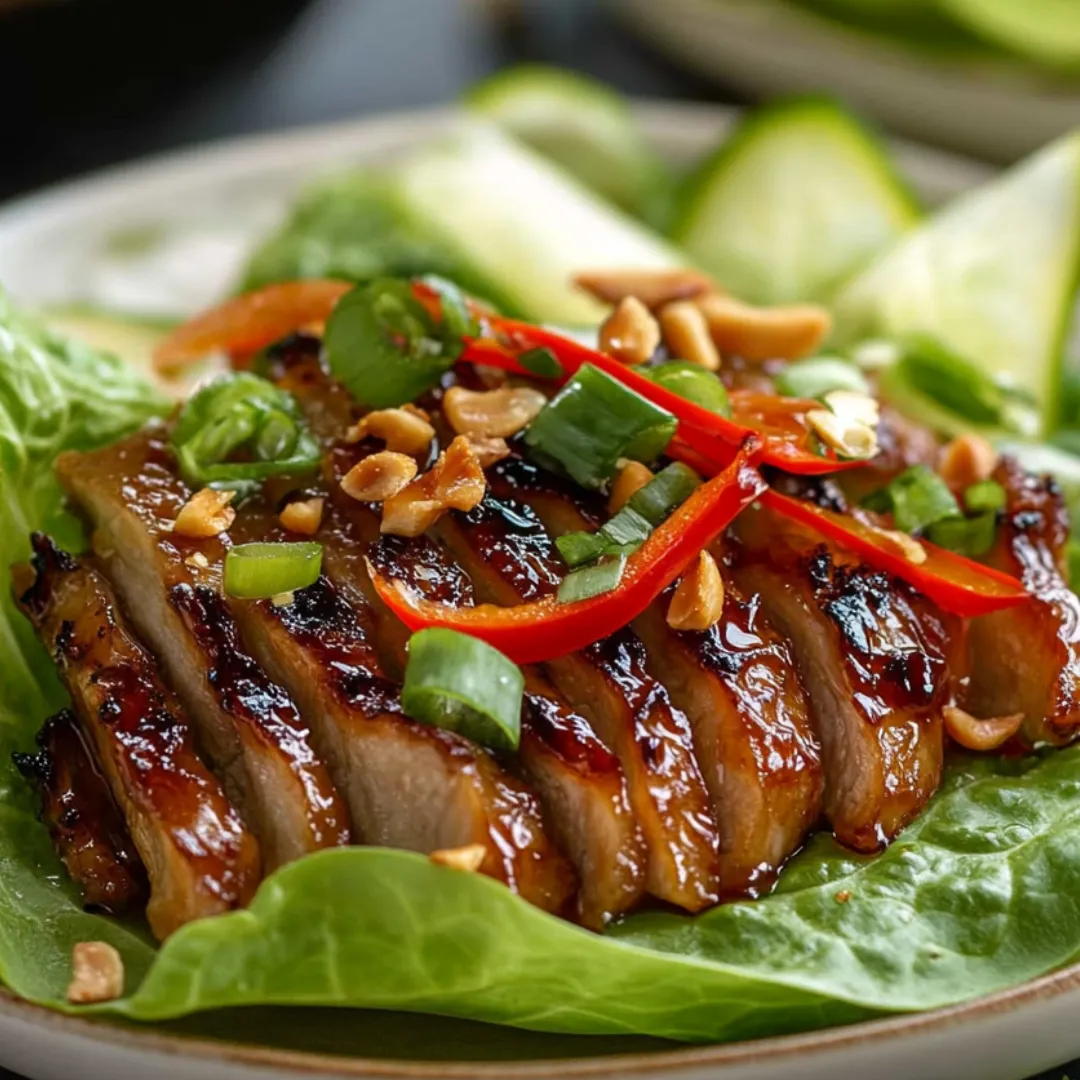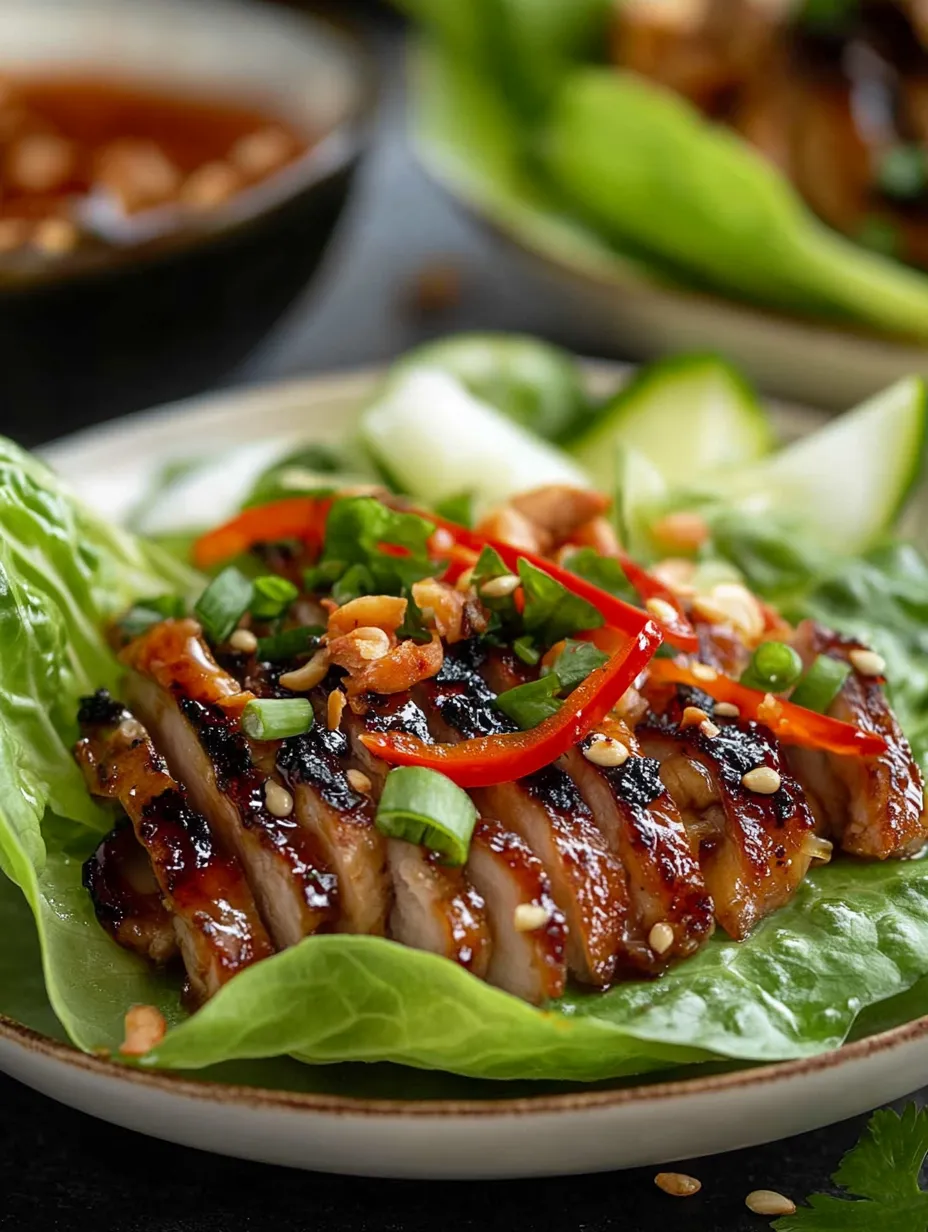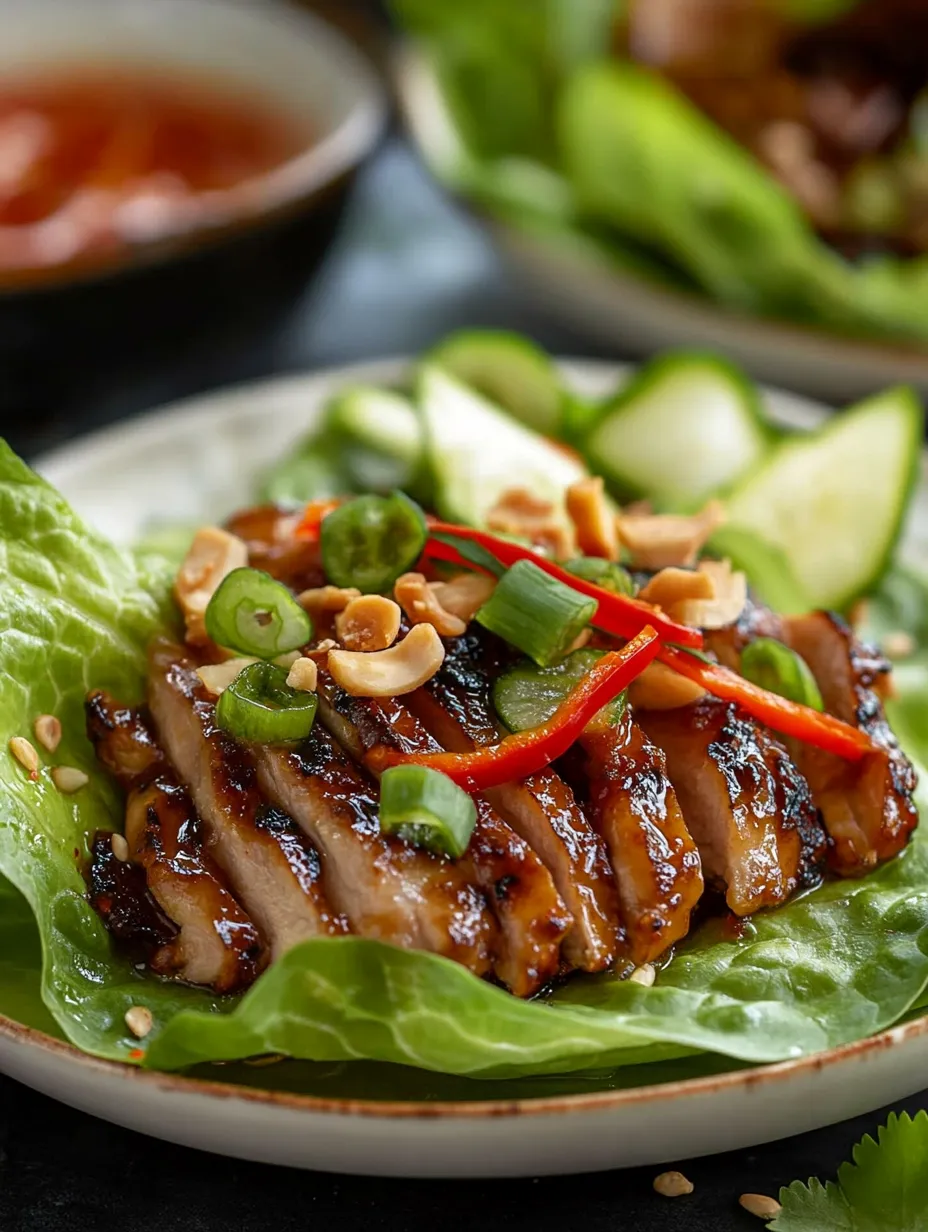 Pin it
Pin it
These Vietnamese lettuce wraps transform ordinary ingredients into an extraordinary meal that delights all your senses. The magic happens when crisp lettuce leaves cradle caramelized, sticky-sweet chicken alongside fresh herbs, crunchy vegetables, and delicate rice vermicelli. Each bite delivers a perfect balance of textures and flavors – from the umami-rich marinated chicken to the bright herbs and the unforgettable Nuoc Cham dipping sauce that ties everything together with its salty-sweet-sour perfection. Ready in just about 30 minutes of active cooking time, these wraps bring the vibrant street food experience of Vietnam right to your summer table without heating up your kitchen. They're refreshing, customizable, and guaranteed to become your new warm-weather favorite.
I discovered my love for these wraps years ago during a sweltering July when the thought of turning on my oven seemed unbearable. The first time I served them at a backyard gathering, I noticed something unusual – the typical dinner chatter fell silent as everyone focused entirely on their food, occasionally murmuring with delight between bites. What surprised me most was watching my herb-avoiding nephew pile fresh mint and cilantro onto his wraps without hesitation. Now these appear on our table at least twice a month during summer, and guests inevitably request the recipe before leaving.
Essential Ingredients
- Butter Lettuce: These tender yet sturdy leaves form the perfect edible vessel with their naturally cup-like shape. Their mild, sweet flavor provides the ideal backdrop for the bold fillings without competing. Look for heads with intact, unblemished leaves and a fresh, bright appearance
- Boneless Chicken Thighs (1.5 pounds): Their higher fat content means more flavor and moisture retention, resulting in juicy, caramelized perfection. They're far more forgiving than breast meat, which can easily dry out during cooking
- Lemongrass (2 stalks): This citrusy, floral ingredient is essential for authentic Vietnamese flavor. Look for firm stalks with a pale yellow-green base. Remove the tough outer layers and finely mince the tender inner portion using a microplane grater for best results
- Fish Sauce (3 tablespoons): The umami backbone of Vietnamese cuisine. Don't be deterred by its potent aroma – when balanced with other ingredients, it creates depth that can't be replicated. Look for bottles labeled 'first press' or 'extra virgin' for the best quality
- Dark Soy Sauce (1 tablespoon): Provides both rich color and subtle sweetness. Its thicker consistency helps the marinade cling to the chicken
- Brown Sugar (2 tablespoons): Creates the signature caramelization on the chicken while balancing the saltiness of the sauces. Dark brown sugar offers more complex molasses notes
- Rice Vermicelli (4 ounces): These delicate white noodles add substantial texture without heaviness. They absorb the flavors of the sauce beautifully
- Fresh Herbs (Mint and Cilantro): These aren't optional garnishes but essential flavor components. Their brightness cuts through the rich chicken and adds authentic Vietnamese character
- Nuoc Cham Sauce: This transformative dipping sauce/dressing combines fish sauce, sugar, lime juice, garlic, and bird's eye chili. It provides the perfect flavor bridge between all components and shouldn't be skipped
 Pin it
Pin it
Step-by-Step Cooking Instructions
- Prepare the Chicken Marinade:
- In a medium mixing bowl, combine 2 tablespoons of fish sauce, 1 tablespoon dark soy sauce, 1 tablespoon light soy sauce, 1 tablespoon oyster sauce, 2 tablespoons brown sugar, 2 tablespoons finely minced lemongrass, 2 cloves of minced garlic, and 1 finely minced shallot. Whisk everything together until the sugar dissolves completely. The marinade should have a rich, dark color and aromatic fragrance from the lemongrass and garlic. This complex blend of ingredients creates layers of flavor that permeate the chicken.
- Marinate the Chicken:
- Add 1.5 pounds of boneless, skinless chicken thighs to the marinade bowl. Using tongs or clean hands, turn the chicken several times to ensure each piece is thoroughly coated. Cover the bowl with plastic wrap and refrigerate for at least 30 minutes, though 2 hours will yield even better flavor. During this time, the salt and sugar in the marinade work to both flavor and tenderize the meat. The longer marinating time allows the lemongrass and garlic to fully infuse into the chicken. If you're in a hurry, even 15 minutes will impart good flavor due to the potency of the marinade.
- Prepare the Nuoc Cham Dipping Sauce:
- While the chicken marinates, make the essential dipping sauce. In a small bowl, combine 3 tablespoons fish sauce, 3 tablespoons white sugar, 3 tablespoons fresh lime juice, 6 tablespoons water, 1 small clove of minced garlic, and 1 finely chopped bird's eye chili (seeds removed for less heat if desired). Stir until the sugar completely dissolves. Taste and adjust the balance – it should hit salty, sweet, sour, and spicy notes in perfect harmony. If too strong, add a bit more water; if too mild, add more fish sauce or lime juice. This sauce can be made several days ahead and stored in the refrigerator – in fact, the flavors improve with time.
- Cook the Rice Vermicelli:
- Bring a medium pot of water to a boil. Turn off the heat, add 4 ounces of dry rice vermicelli, and let sit for 2-3 minutes until just tender but still slightly firm (al dente). Check the package instructions as cooking times vary by brand. Be careful not to overcook, as the noodles will continue softening slightly after draining. Rinse immediately under cold running water to stop the cooking process and prevent sticking. Drain thoroughly and set aside. The cold rinse not only halts cooking but also gives the noodles the perfect temperature for a refreshing wrap.
- Cook the Marinated Chicken:
- Heat a large skillet or grill pan over medium-high heat. Add 1 tablespoon of neutral oil (like canola or avocado). When the oil is shimmering but not smoking, add the marinated chicken in a single layer, working in batches if necessary to avoid overcrowding. Cook for 5-6 minutes per side until deeply caramelized and cooked through to an internal temperature of 165°F. The sugar in the marinade will create a beautiful, sticky glaze. Transfer to a cutting board and let rest for 5 minutes before slicing into thin strips. This resting period allows the juices to redistribute throughout the meat, ensuring it stays moist.
- Prepare the Fresh Components:
- While the chicken cooks and rests, prepare the vegetables and herbs. Julienne 2 medium carrots and 1 English cucumber into thin matchsticks about 2-3 inches long. Separate and wash the butter lettuce leaves, being careful to keep them intact. Pat them dry with paper towels or use a salad spinner. Roughly chop about ½ cup each of fresh mint and cilantro leaves. The preparation of these fresh elements is critical – the thin vegetable slices create the perfect texture, while careful handling of the lettuce ensures it maintains its cup-like shape for easy filling.
- Create Your Assembly Station:
- Arrange all components in separate serving dishes to create a build-your-own wrap bar: lettuce leaves, sliced chicken, rice vermicelli, julienned vegetables, chopped herbs, and the Nuoc Cham sauce in a small bowl with a spoon or small ladle. This presentation not only looks appealing but allows each person to customize their wraps according to their preferences. The interactive nature of assembly makes this perfect for casual entertaining.
- Build and Enjoy:
- To assemble each wrap, hold a lettuce leaf in your palm like a cup. Place a small amount of rice vermicelli at the bottom, followed by a few pieces of chicken, vegetables, and a sprinkle of herbs. Drizzle with a spoonful of Nuoc Cham sauce. Fold the sides of the lettuce leaf inward and roll from the bottom up, similar to a small burrito, being careful not to tear the leaf. The wraps are best enjoyed immediately after assembly, creating the perfect balance of warm chicken against cool, crisp vegetables.
My relationship with these lettuce wraps deepened during a particularly stressful period in my life when I found unexpected calm in the rhythmic preparation of each component. There's something almost therapeutic about julienning vegetables with precision, arranging the colorful elements in separate bowls, and watching family members create their own perfect bites. I've noticed that even at our most rushed family dinners, this meal somehow slows everyone down – perhaps it's impossible to eat these wraps quickly or check your phone while assembling them. Whatever the reason, they've become our reset button on hectic weeks, bringing us back to the table in both body and mind.
The Art of Lettuce Selection
Not all lettuce varieties are created equal when it comes to wrapping capabilities. While butter lettuce (also known as Boston or Bibb) is the gold standard with its naturally cup-shaped, pliable leaves and subtle sweetness, you have options. Green leaf lettuce works in a pinch, though its more irregular shape makes for messier eating. Romaine hearts provide a satisfying crunch but may crack when folded, better suited for 'boats' than true wraps. Iceberg offers maximum crunch but minimal flavor and flexibility. The often-overlooked red leaf lettuce makes a visually striking alternative with properties similar to green leaf. Whatever your choice, look for the freshest heads possible – crisp leaves with no browning at the edges, a sure sign they'll maintain their structural integrity through serving.
Creating a Weeknight-Friendly Version
While this recipe is already relatively quick, it can be streamlined even further for busy weeknights without sacrificing flavor. Marinate the chicken overnight, allowing you to simply cook it when you get home. Pre-cook the vermicelli and refrigerate with a tiny bit of oil to prevent sticking. Julienne vegetables up to two days ahead and store in water-filled containers to maintain crispness. The Nuoc Cham sauce actually improves with a day or two of refrigeration as flavors meld. With these advance preparations, you can have dinner on the table in under 15 minutes. For the ultimate time-saver, consider using high-quality rotisserie chicken – while it lacks the caramelized edges of the marinated version, it still creates a delicious wrap when tossed with a bit of the marinade mixture just before serving.
Seasonal Adaptations
The beauty of these Vietnamese lettuce wraps lies in their adaptability throughout the year. In spring, add tender asparagus spears, thinly sliced on the diagonal. Summer calls for sweet corn kernels and quartered cherry tomatoes. Fall welcomes thinly sliced apple or pear for unexpected sweetness and crunch. Winter can incorporate quick-pickled radishes for bright color and sharp flavor contrast. The protein can shift seasonally too – substitute grilled shrimp in summer, thinly sliced beef in winter, or marinated tofu for vegetarian versions year-round. The core flavors remain consistent through these variations, maintaining the dish's essential character while keeping it fresh and relevant regardless of what's available at your market.
Entertaining with Lettuce Wraps
Few dishes are better suited to casual entertaining than these interactive lettuce wraps. For a stress-free gathering, prepare all components ahead of time, arranging them in beautiful serving dishes shortly before guests arrive. Consider adding complementary sides like chilled rice paper spring rolls, a simple cucumber salad dressed with rice vinegar, or a batch of crispy wonton chips. For drinks, light Asian lagers, dry Riesling, or a lemongrass-infused iced tea complement the flavors perfectly. The DIY nature of assembly naturally encourages conversation and movement, making these ideal for cocktail-style parties where guests might mingle rather than sit for a formal meal. Provide small plates and plenty of napkins – these can be deliciously messy in the most satisfying way.
 Pin it
Pin it
Expanding Your Vietnamese Pantry
Once you've mastered these lettuce wraps, you'll likely want to explore more Vietnamese cooking. Consider investing in a few key ingredients that will open up a world of recipes: Vietnamese cinnamon (cassia bark) with its more intense flavor than regular cinnamon; star anise for complex licorice notes; palm sugar, which offers caramel undertones superior to regular sugar in many applications; and rice paper wrappers for traditional fresh spring rolls. Store these ingredients properly – whole spices in airtight containers away from light and heat, palm sugar well-wrapped in the refrigerator, and rice paper in a cool, dry place. With these additions to your pantry, you'll be prepared to create authentic Vietnamese dishes whenever inspiration strikes.
After years of experimenting with different Vietnamese recipes, these lettuce wraps remain my go-to for both everyday meals and entertaining. There's something magical about how simple ingredients transform through thoughtful preparation and assembly. The balance of flavors – salty fish sauce, sweet sugar, sour lime, fresh herbs, and the umami-rich chicken – creates a complexity that belies the dish's straightforward nature. What I love most is watching newcomers experience that first perfect bite, where all components come together in harmony. Their eyes widen in surprise and delight, often followed by appreciative silence as they focus entirely on the flavors unfolding in their mouth. That moment of culinary connection makes all the chopping and prepping worthwhile, reminding me why sharing food remains one of life's most fundamental joys.
Frequently Asked Questions
- → Can I make these lettuce wraps ahead of time?
- You can prepare all the components ahead of time and store them separately. Marinate and cook the chicken, prepare the dressing, and chop the vegetables up to a day in advance. Assemble just before serving to keep the lettuce crisp and prevent sogginess.
- → What type of lettuce works best for these wraps?
- Butter lettuce (Boston or Bibb) is ideal as it has soft, pliable leaves that form a good cup shape. Romaine hearts also work well as they provide more crunch. Iceberg lettuce is another option that provides crispness, though it's more challenging to wrap.
- → What can I substitute for fish sauce?
- While fish sauce provides authentic flavor, you can substitute with a mixture of soy sauce and lime juice (2:1 ratio) plus a pinch of sugar. For a vegetarian version, use mushroom-based vegetarian fish sauce or miso paste diluted with water.
- → Can I use chicken breast instead of thighs?
- Yes, chicken breast works, though it tends to be drier than thighs. If using breast meat, marinate longer (at least 1 hour) and be careful not to overcook. Reduce cooking time to about 3-4 minutes per side, depending on thickness.
- → What other vegetables can I add to these wraps?
- Bean sprouts, thinly sliced bell peppers, shredded cabbage, matchstick radishes, or thinly sliced snow peas all make excellent additions. For extra crunch, consider adding crushed peanuts or fried shallots as a topping.
